Log in or create new account to save this product to your wishlist.
The 5 Most Common Lawn Problems (and how to overcome them!)
We all want a perfect lawn, but sometimes it's difficult to achieve. Read on for the solutions to the 5 most common lawn problems.
Latest articles
7 MIN 22 Jul How to keep your lawn in shape this summer 9 MIN 15 Jul Watering Your Garden: 10 Top Tips! 11 MIN 15 Jul Is Your Grass Type Right for your Garden? 11 MIN 10 Sep Create Your Low-Maintenance Garden – Tips and Ideas 11 MIN 08 Sep The Ultimate Guide to Choosing the Perfect Hedges for Your Garden 12 MIN 30 Aug The Top 20 Evergreen Climbers to Transform Your GardenEveryone wants a beautiful lawn, but we often face obstacles that feel like they’re difficult to overcome. Perhaps your lawn floods in heavy rain? Maybe your grass is patchy, with areas that just won’t grow? Read on – for we’re here to address the five most common lawn problems.
- Lawn Problem #1: Poor growth in the shade
- Lawn Problem #2: My lawn keeps flooding
- Lawn problem #3: Patches of your lawn keep dying
- Lawn problem #4: My lawn is pale and looking sorry for itself
- Lawn problem #5: My lawn is full of moss and weeds
Few of us are lucky enough to have a lawn that looks after itself. And, in the end, we just resign ourselves to the fact that we’re unlikely ever to have a lawn like Downton Abbey.
Well, this article is about the 5 most common lawn problems, with solutions to overcome them. So, no matter what your lawn looks like right now, it IS possible to improve it.
Ready? Let’s go.
Lawn Problem #1: Poor growth in the shade
You probably don’t worry too much about shade if you have a south-facing garden. However, your grass possibly struggles to grow at the bottom of the garden where your fence shades your lawn.
But for the rest of us, we have to deal with full or partial shade over our lawns. And grass just doesn’t seem to grow as well if it doesn’t get full sun.
This problem is easily solved because it’s likely a grass variety issue.
Perennial ryegrass and red fescue are particularly shade-tolerant, so these are the varieties that will grow well in darker areas of your garden. However, you probably don’t want to buy several types of seed and apply them to different areas of your lawn, depending on the light it receives.
MOOWY’s Shade and Sun grass seed is the perfect solution. With a high percentage of perennial ryegrass and red fescue (with a touch of Kentucky Bluegrass), Shade and Sun provides excellent coverage in the shade AND thrives in full sun.
Check out our article: How to improve your lawn in a shaded garden for more information.
Lawn Problem #2: My lawn keeps flooding
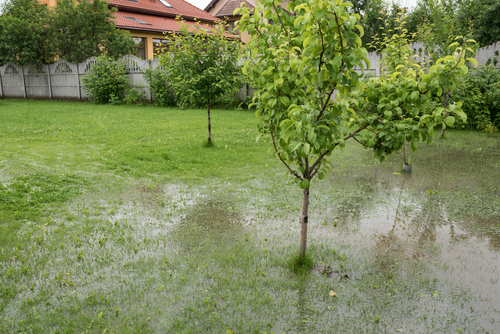
There could be many reasons why your lawn might flood. The two main ones are:
Your soil is too heavy or compacted
The surface is uneven
Heavy clay soil
Clay soil is usually high in nutrients (good times), but it acts like a sponge and retains water (bad times). This means that clay soils become heavy and waterlogged, and they can lack oxygen, which is essential for healthy growth.
This all adds up to a bit of a pain in the neck for your grass plants, which can die in flooded lawns.
The best way to tackle heavy clay soil is to aerate the earth regularly. Aeration is a process of making holes in the soil surface, bringing air into the roots of your grass plants.
There are several ways to aerate, from digging the tines of your garden fork into the lawn surface to using specialised aeration tools.
For more information on aeration, check out our expert article.
Flooding due to an uneven soil surface
Sometimes puddles occur in your lawn wherever the soil level dips. Unevenness commonly happens around heavy use areas – the goal area on a football pitch often wears down quickly.
A quick fix is to sprinkle some topsoil over the dip in your lawn while overseeding with an appropriate seed mix.
But if your lawn is very unlevel, you might need to renovate the entire lawn. Check out our article about how to level out your lawn.
Lawn problem #3: Patches of your lawn keep dying
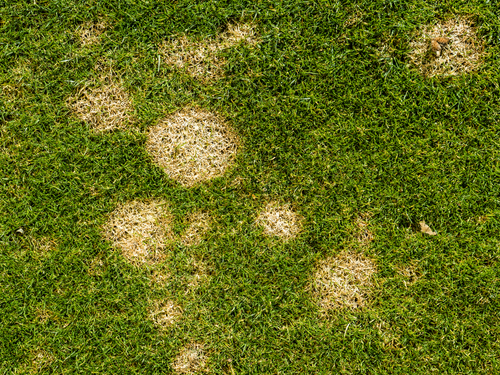
There are many reasons why patches of your lawn die. But the main clue is often in the shape of the patch.
You could have an infestation of chafer grubs or leatherjackets, which can be treated with pesticides. However, many chemical pesticides are prohibited for domestic use – often solely licenced to professional pest controllers.
However, it is possible to tackle pest infestations with biological solutions, such as nematodes. Check out our articles on tackling chafer grubs and leatherjackets for some inspiration.
Alternatively, patches of dying grass could result from animal urine, such as dog or fox wee. Some animal urines are high in nitrogen, which can kill your grass.
And while there are some old wives’ tales that suggest spreading human male urine around the perimeter of your garden will prevent foxes from visiting, there’s limited evidence to suggest it works.
And you probably don’t want your garden smelling like a latrine.
If your garden is troubled by foxes at night, you could try an electronic device to scare them away.
And check out our expert article on repairing your patchy lawn.
Lawn problem #4: My lawn is pale and looking sorry for itself
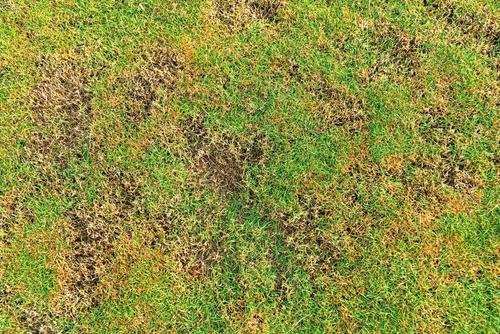
Discoloured grass is usually an indication of poor nourishment. If your grass is going yellow or brown, it could need fertilising.
First, it’s wise to rule out dehydration by checking the moisture level of your lawn. Your grass is a plant, and it needs at least 4cm of water every week to thrive. So, if the earth is dry, give your lawn a hosing.
However, if your soil is moist and you’re watering your lawn regularly, the discolouration is most likely a nutrient deficiency problem.
Luckily, nutrient deficiency is easily remedied using a good quality fertiliser. Remember, over fertilising can scorch your grass, so if you’re already fertilising your lawn and it’s still going yellow or brown, it could be that you’re overdoing it.
Check out our excellent article on how to fertilise your lawn.
Lawn problem #5: My lawn is full of moss and weeds
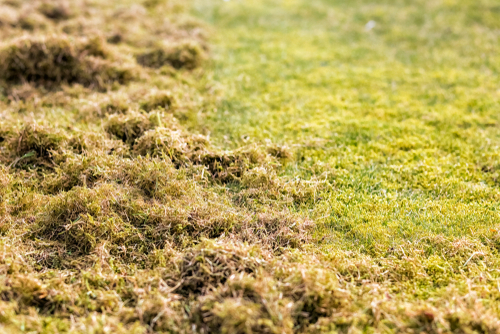
If your lawn has become spongy underfoot, you could have a problem with moss. Moss can feel quite nice to walk on, but don’t let it overtake your lawn because it suffocates your grass plants.
Moss grows in a thick layer over the soil surface and eventually kills your grass, so it’s a bad idea to leave it to grow because it reduces your lawns resistance to disease, weeds, and pests.
Mossy lawns are often troubled by weeds, which take advantage of your lawn’s vulnerable condition. In combination, moss and weeds significantly stunt your grass’s growth.
There is a simple solution, however.
Firstly, you could scarify your lawn, removing the thatch layer and ripping up the weeds from their roots. Secondly, add moss killer – MOOWY’s 2-in-1 moss killer and fertiliser ensures that the damage done to the lawn from scarifying is repaired with extra nutrients while killing off your moss problem.
Check out our expert guide to scarifying your lawn.
Ready to start working on your lawn? Or do you need some more help?
We hope we’ve given you some good solutions to the most common lawn problems. But get in touch if you have any questions.
Alternatively, check out our extensive Help section.
Thanks for reading.
Leave a comment
Your answer will be displayed on the site and the interested party will be notified by email.
Leave a comment
Have a question or want to share your experience? Leave us a comment.
Read more
The best tips and tricks for a lush green lawn
 Scarifying Kit
All products after scarifying | Quickly restores the lawn after scarifying | Outsmart weeds quickly with the use of this kit
From: € 39.99
Scarifying Kit
All products after scarifying | Quickly restores the lawn after scarifying | Outsmart weeds quickly with the use of this kit
From: € 39.99
 Spring Lawn Care Kit
MOOWY’s choice for the spring | Quick recovery of your lawn after winter | A strong lawn prevents weeds
From: € 25.99
Spring Lawn Care Kit
MOOWY’s choice for the spring | Quick recovery of your lawn after winter | A strong lawn prevents weeds
From: € 25.99
 Long Lasting Lawn Fertiliser
Effective for 90 days | See results in 14 days! | Suitable for all types of grass and soil
From: € 13.99
Long Lasting Lawn Fertiliser
Effective for 90 days | See results in 14 days! | Suitable for all types of grass and soil
From: € 13.99
Do you want a lawn calendar?
🌱 All important maintenance moments for your lawn during the year. Leave your email and we will send you the lawn calendar for free.
Enter your email
Receive the lawn calendar in the mail
Enjoy a green lawn all year round!




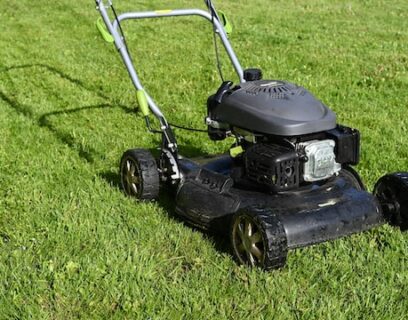

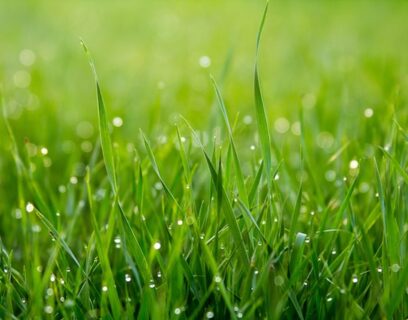





Comments (0)
There are no comments yet. Well then, what are you waiting for to
Be the first to write your comment!inaugurate this pretty page?
Do you have some comments?